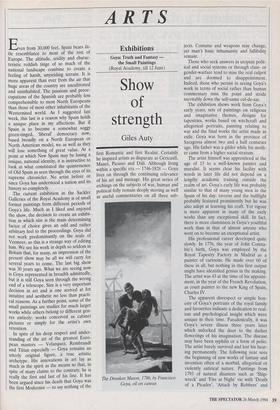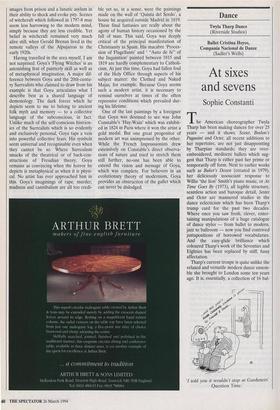ARTS
Exhibitions
Goya: Truth and Fantasy — the Small Paintings (Royal Academy, till 12 June)
Show of strength
Giles Auty
Een from 30,000 feet, Spain bears lit- tle resemblance to most of the rest of Europe. The altitude, aridity and charac- teristic reddish tinge of so much of the national landscape combine to create a feeling of harsh, unyielding terrain. It is more apparent than ever from the air that huge areas of the country are uncultivated and uninhabited. The passions and preoc- cupations of the Spanish are probably less comprehensible to most North Europeans than those of most other inhabitants of the Westernised world. As I suggested last week, this last is a reason why Spain holds a unique place in my affections. But if Spain is to become a somewhat soggy green-tinged, 'liberal' democracy now, based broadly on a North European or North American model, we as well as they will lose something of great value. At a point at which New Spain may be losing a unique, national identity, it is instructive to look at what constituted the quintessence of Old Spain as seen through the eyes of its supreme chronicler. No artist before or since Goya has understood a nation and its history so completely. The current exhibition in the Sackler Galleries of the Royal Academy is of small format paintings from different periods of Goya's life. Much as I liked and enjoyed the show, the decision to create an exhibi- tion in which size is the main determining factor of choice gives an odd and rather arbitrary feel to the proceedings. Goya did not work predominantly on the scale of Vermeer, so this is a strange way of editing him. We see his work in depth so seldom in Britain that, for many, an impression of the present show may be all we will carry for several years to come. The last big show was 30 years ago. What we are seeing now is Goya represented in breadth admittedly, but it is still Goya seen through the wrong end of a telescope. Size is a very important decision in art and is one arrived at for intuitive and aesthetic no less than practi- cal reasons. As a further point, some of the small paintings are studies for much larger works while others belong to different gen- res entirely: works conceived as cabinet pictures or simply for the artist's own retention.
In spite of his deep respect and under- standing of the art of the greatest Euro- pean masters — Velazquez, Rembrandt and Titian especially — Goya remains an utterly original figure, a true artistic archetype. His innovations in art lay as much in the spirit as the means so that, in Spite of many claims to the contrary, he is really the first and last of his line. It has been argued since his death that Goya was the first Modernist — to say nothing of the first Romantic and first Realist. Certainly he inspired artists as disparate as Gericault, Manet, Picasso and Dali. Although living within a specific era — 1746-1828 — Goya lives on through the continuing relevance of his art and message. His great series of etchings on the subjects of war, human and political folly remain deeply moving as well as useful commentaries on all three sub- The Drunken Mason, 1786, by Francisco Goya, oil on canvas jects. Costume and weapons may change, yet man's basic inhumanity and fallibility remain.
Those who seek answers in utopian polit- ical and social systems or through class- or gender-warfare tend to miss the real culprit and are doomed to disappointment. Indeed, those who persist in seeing Goya's work in terms of social rather than human commentary miss the point and stride inevitably down the self-same cul-de-sac.
The exhibition shows work from Goya's early years, sets of paintings on religious and imaginative themes, designs for tapestries, works based on witchcraft and allegorical portraits, painting relating to war and the final works the artist made in exile. Goya was born in the province of Saragossa almost two and a half centuries ago. His father was a gilder while his moth- er came from a higher social stratum.
The artist himself was apprenticed at the age of 13 to a well-known painter and muralist. It seems clear his facility with words in later life did not depend on a lengthy academic training outside the realm of art. Goya's early life was probably similar to that of many young men in the Spain of his day: taverns and the bullfight probably featured prominently but he was also adept at learning his craft. Yet vigour is more apparent in many of the early works than any exceptional skill. In fact, there is more clumsiness in Goya's youthful work than in that of almost anyone who went on to become an exceptional artist.
His professional career developed quite slowly. In 1776, the year of John Consta- ble's birth, Goya was employed by the Royal Tapestry Factory in Madrid as a painter of cartoons. He made over 60 of these in all, but nothing in this first output might have identified genius in the making. The artist was 43 at the time of his appoint- ment, in the year of the French Revolution, as court painter to the new King of Spain, Charles IV.
The apparent disrespect or simple hon- esty of Goya's portraits of the royal family and favourites indicate a dedication to real- ism and psychological insight which were unique in their time. Paradoxically, it was Goya's severe illness three years later which unlocked the door to the darker flowerings of his imagination. The disease may have been syphilis or a form of polio. The artist barely survived and lost his hear- ing permanently. The following year sees the beginning of new works of fantasy and invention often of a morbid, allegorical or violently satirical nature. Paintings from 1793 of natural disasters such as 'Ship- wreck' and 'Fire at Night' vie with 'Death of a Picador', 'Attack by Robbers' and images from prison and a lunatic asylum in their ability to shock and evoke pity. Scenes of witchcraft which followed in 1797-8 may seem less harrowing to the modern mind, simply because they are less credible. Yet belief in witchcraft remained very much alive still, when Gerald Brenan lived in the remote valleys of the Alpujarras in the early 1920s.
Having travelled in the area myself, I am not surprised. Goya's 'Flying Witches' is an astonishing feat of painterly skill as well as of metaphysical imagination. A major dif- ference between Goya and the 20th-centu- ry Surrealists who claimed to draw from his example is that Goya articulates what I describe best as a shared language of demonology. The dark forces which he depicts seem to me to belong to ancient folk myth and memory — to a collective language of the subconscious, in fact. Unlike much of the self-conscious histrion- ics of the Surrealists which is so evidently and exclusively personal, Goya taps a vein into powerful collective fears. His symbols seem universal and recognisable even when they cannot be so. Where Surrealism smacks of the theatrical or of back-con- structions of Freudian theory, Goya remains as convincing when the horror he depicts is metaphysical as when it is physi- cal. No artist has ever approached him in this. Goya's imaginings of rape, murder, madness and cannibalism are all too credi- ble yet so, in a sense, were the paintings made on the wall of `Quinta del Sordo', a house he acquired outside Madrid in 1819. These final fantasies are really about the agony of human history occasioned by the fall of man. This said, Goya was deeply critical of the principal manifestation of Christianity in Spain. His macabre 'Proces- sion of Flagellants' and "Auto de fe" of the Inquisition' painted between 1815 and 1819 are hardly complementary to Catholi- cism. At just this time, Goya had fallen foul of the Holy Office through aspects of his subject matter: the Clothed and Naked Majas, for example. Because Goya seems such a modern artist, it is necessary to remind ourselves at times of the often repressive conditions which prevailed dur- ing his lifetime.
One of the last paintings by a foreigner that Goya was destined to see was John Constable's 'Hay-Wain' which was exhibit- ed in 1824 in Paris where it won the artist a gold medal. But one great progenitor of modern art was unimpressed by the other. While the French Impressionists drew extensively on Constable's direct observa- tions of nature and tried to stretch them still further, no-one has been able to extend the vision and message of Goya, which was complete. For believers in an evolutionary theory of modernism, Goya provides an obstruction of the gullet which can never be dislodged.



























































 Previous page
Previous page